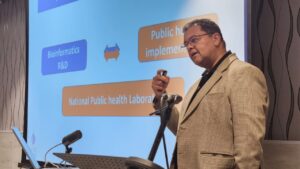
Vaccine development is a lengthy process that could take 10-15 years. Efforts to develop the corona virus disease 2019 (COVID-19) vaccine have turned out to be faster. On 30 January 2020, the World Health Organization (WHO) declared COVID-19 a public health emergency of international concern (PHEIC) giving scientists and academics the green light to start developing COVID-19 vaccines.
In just over a year, between 11 December 2020 and 30 April 2021, five COVID-19 vaccines were authorised by the European Union (EU), U.S. Food and Drug Administration (FDA) and WHO for emergency use. These include the Pfizer-BioNTech Comirnaty vaccine, two Oxford AstraZeneca vaccines, Johnson & Johnson Janssen vaccine and the Moderna COVID-19 vaccine. On the 7th of May 2021, WHO granted emergency approval of another vaccine, Sinopharm. However, the Johnson & Johnson Janssen vaccine was temporarily paused due to adverse events such as blood clots and death after the vaccination.
Within five months since the first authorisation of COVID-19 vaccines, 3.5% of the world’s population was fully vaccinated for COVID-19 as of 1 May 2021. The quick availability of vaccines and the rollout of vaccinations deserve commendation; but some key questions linger. Is the COVID-19 vaccination rate low? Are the vaccines safe? What are the vaccine acceptance rates globally? Various answers, with some cutting across the three questions, can be derived from different publications relating to COVID-19. These reasons are largely an interplay of socio-political and socio-economic factors where individuals (un)intentionally fall on different points on two continuums: the “vaccine eligible” to “vaccine ineligible” continuum; and the “pro-vaccine” to “anti-vaccine” continuum.
Vaccine eligible – vaccine ineligible continuum
Not everyone is eligible for COVID-19 vaccination. The vaccines are not developed for children as the minimum age is either 16 years or 18years. The absence of child vaccines is a growing concern especially where there is an increase in COVID-19 new cases and fatalities among children. Amongst adults, doses are limited resulting in prioritization of high-risk groups. Healthcare workers at high to very high risk of acquiring COVID-19, the elderly, and people with co-morbidities are some of the priority groups recommended to vaccinate. For healthcare workers, this is largely due to them being on the frontline assisting suspected or known COVID-19 cases; and the elderly and people with comorbidities having weakened immune systems.
Safety of the COVID-19 vaccines is a concern among certain chronic conditions, pregnant and lactating women and people with certain allergies. There is little knowledge on the safety of the vaccines among people living with HIV as Phase III clinical trials of most of the authorised vaccines largely included other chronic conditions that are not HIV. Similarly, little data are available on the safety of the vaccines among pregnant and lactating mothers. The use of the Pfizer- BioNTech vaccine is not recommended for people with severe allergies. In December 2020, initial doses of Pfizer-BioNTech COVID-19 vaccine were recommended for healthcare personnel and long-term care facility residents and Moderna COVID-19 vaccine was recommended for Emergency Use Authorization (EUA) in the United States of America. Within two weeks, 0,2% and 0.03% adverse events, respectively, were reported after the inoculation.
Access to cost-effective COVID-19 vaccines by national governments also plays a pivotal role on the type of vaccines available to their nations. For instance, the COVAX facility is described as using an algorithm or “allocation framework” for equitable distribution of the AstraZeneca and Pfizer-BioNTech vaccines largely among low and middle income countries. Of the five vaccines authorised by the regulatory bodies in Europe and United States, AstraZeneca has the lowest efficacy rate of 60%, cheapest cost per dose ranging between 2- 5 US dollars per dose, and is “suitable for low- and middle-income countries due to easy storage requirements”. Other nations such as China, Russia, India and Kazakhstan are seeking alternatives by developing their own COVID-19 vaccines that have varied efficacy rates with uptake within their countries and other countries.
Looking at the efficacy of vaccines, the five vaccines authorised by the regulatory bodies in Europe and the United States were determined after running larger clinical trials; but other vaccine alternatives in China, Russia, India and Kazakhstan have dissimilar or little data available. The efficacy rates of the five major vaccines range between 60% -95%. Most types of vaccines that are Europe and United States authorized; differ from the alternative vaccines outside these geographical regions. Some alternative vaccines are being developed using inactivated vaccines, live attenuated vaccines and subunit vaccines whilst the major five vaccines are developed using messenger RNA (mRNA) vaccine and viral vector vaccine. Pfizer-BioNTech and Moderna are mRNa vaccines whilst AstraZeneca and Johnson & Johnson Janssen are viral vector vaccines.
Pro-vaccine – anti-vaccine continuum
Research was conducted amongst sub-groups in countries with high COVID-19 incidence rates. In June 2020, a survey amongst the adult population across 19 countries indicated that vaccine acceptance rates were over 80% amongst the Asian respondents in China, South Korea and Singapore; relatively high among middle income countries such as Brazil, India and South Africa; and less than 55% in Russia. In another survey amongst the adult population in Kuwait, the willingness to get vaccinated against COVID-19 was moderate to relatively high. Willingness to get vaccinated increased as the self-perceived chances of contracting the infection increased.
Evidence relating to adverse events and other factors, have led to an increase in vaccine hesitancy, a threat to immunization programs. For example, vaccine hesitancy amongst medical students and healthcare workers is due to concerns around adverse effects and ineffectiveness, deficient data regarding the vaccine’s adverse effects and insufficient information regarding the vaccine itself. In the United Kingdom, vaccine hesitancy was higher in women, younger age groups, those with lower education levels, Black and Pakistani/Bangladeshi ethnic groups. Approximately one third of an adult nationally representative sample in Ireland and UK were also hesitant to be vaccinated. In France, a survey amongst an adult population revealed that 29% of the respondents would not want to be vaccinated, and of these, the majority were women. In a Finnish study, “the strongest predictor of COVID-19 vaccination intentions was trusting the safety of the potential vaccine”. To achieve a high vaccine uptake, health information emphasising on the safety of the vaccine by health officials is promulgated.
A systematic search on the 25th of December 2020 indicated low acceptance rates among the Middle East, Russia, Africa and several European countries. Notably, surveys among healthcare workers show that vaccine acceptance rates sat at 27.7% in the Democratic Republic of the Congo and 78.1% in Israel. In other settings such as Hong Kong, low vaccine acceptance rates were noted amongst the general population and amongst nurses. Over 60% of respondents amongst adults in a survey, preferred to be vaccinated out of self-will and not through a compulsory program.
What next?
The complexities around the development, distribution and vaccine acceptance cannot be negated. Access to correct information on COVID-19 vaccines and transparency on the type of COVID-19 vaccines available remain important for people to be informed on what choice to make on receiving a COVID-19 vaccine. We need to ensure that our efforts to stop the COVID-19 pandemic includes active engagement with the public to build trust. Anything less will be an indictment against our best efforts to find solutions to the COVID-19 pandemic.
by Rangarirai Matima



